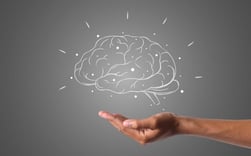Index Content
Neuromarketing is one of the neuroscience techniques applied to traditional marketing. The main objective of this discipline is to know and understand the levels of attention that users show to different advertising stimuli in order to know how they will act when faced with a purchase based on the interaction of the neuronal base of our brain when faced with a product or service that we wish to acquire.
Therefore, neuromarketing could be translated as the way that brands have to be present in the consumer's subconscious. Would you also like to know how they can do it? Then, stay and read this post.
what is neuromarketing?
The term neuromarketing became known in 2002, when the scientist Ale Smidts, Nobel Prize in Economics, made it known. As defined by Smidts, neuromarketing was based on mind research techniques that allowed discovering how the subconscious worked with advertising, in order to allow brands to know how they could take advantage of this resource to obtain a greater number of customers.
In marketing, the use of these neuroscience techniques is to seek efficiency and speed in consumer decisions. Knowing which stimuli are paid more attention to and have a direct influence on a person's behaviour when it comes to making decisions and which, however, are not. Basically, what this discipline tries to do is to better understand people and know how to act when selling a product or service, without the intention of manipulating people's heads, but to know with which stimuli we can capture a higher percentage of attention towards our brand.
In addition, neuromarketing also tries to understand the brain's decision-making processes that lead us to buy a certain product.
On many occasions, we end up receiving an excess of advertising that ends up saturating our brain and makes us not know which product to choose because all products may seem similar or because all brands try to sell us the same thing. This saturation can be stopped when neuromarketing acts on our brain. For example, when we decide to buy a bag of crisps and go to the supermarket, we find many options that will make us hesitate. However, we will always end up choosing those that are more stimulating for our brain at that moment, depending on what we feel we need at that specific moment.
Therefore, we can say that the main function of neuromarketing is to analyse the level of attention of a consumer towards a specific stimulus and the sensory responses that this stimulus produces. This is why, as neuromarketing is based on playing with the senses, there are different types of neuromarketing, according to their method of action. Let's take a look at them:
- Visual neuromarketing: This is the type of neuromarketing that is based on the stimuli we receive through the sense of sight. For example, using the colour yellow to set prices gives us the sensation of an offer, using the colour green in products makes us relate them to words such as "organic" or "ecological". This also includes the use of words that generate stimuli when we read them, for example: "offer", "2x1", "250 ml plus free" or reading "0.99" cents in the price of a product instead of 1€.
- Auditory neuromarketing: It focuses on the sense of hearing to provide us with stimuli. This type of neuromarketing is the most used, for example, in the music we listen to in establishments. For example, in a young clothes shop the music is lively, festive... making you feel encouraged to buy clothes that you would wear to go out, to go to a party or event... However, in supermarkets or household products shops the music is much calmer, relaxed, inviting you to relax and spend as much time as possible in the establishment and, therefore, buying more products.
- Kinaesthetic neuromarketing: This is the neuromarketing that is based on the other senses: taste, touch and smell. It is one of the types that have the greatest impact on the consumer. For example, the smell of coffee when passing through certain cafés, the smell of freshly baked bread that many bakeries use, etc.
Most famous examples of neuromarketing
Once we have seen what neuromarketing is, how it works and what types there are, we can look at some examples to better understand how it is used in real life. There have been many brands that have used this type of marketing to capture more attention from the user and influence their subconscious when making a purchase decision.
An example would be the case of Lay's: they realised that their products were not having much success among the public who were looking for something healthier to eat and their sales were dropping, so they decided to change the packaging of their products and use lighter colours, for example, changing the yellow colour for beige and brown, which gave the impression that the product was not so ultra-processed and it worked to increase their sales among the "healthier" public.
Another example that also works is the case of MediaMarkt as they always put the prices rounded and it makes the product look visually cheaper, for example, putting "209.00€" instead of "210.00€" makes it more attractive to the eye.
One last example we can cite, although there are infinitely more, is Starbucks. Starbucks is more than just a coffee shop. The atmosphere with pastries, the music, the sofas... make it a much more attractive sensory experience than any other coffee shop.

Five advantages of neuromarketing
As we have seen throughout this post, neuromarketing has many advantages over traditional marketing, but the main ones can be summarised in five, which are the ones that help us to understand the value of using this discipline:
- Knowing other points of view: When campaigns are created that investigate people's subconscious, they help us to know and understand people's behaviour, knowing how they interact with advertising.
- Analysing consumer behaviour: Knowing which stimuli will generate positive emotions in the purchase of a product or which will generate feelings of rejection of our product will help us to understand how to present our products or services to the public.
- Improve the users' shopping experience: When we know how to present our products or services to the public, we will give users a better shopping experience as they will find positive emotions in our brand that will lead them to buy what they were looking for.
- It reinforces the image of our brand: If we know how to sell ourselves to the public, our brand will be important among users and will get a good reputation in order to lead users to choose us.
- Knowing the common and scalable behavioural patterns: Once we have studied the behavioural patterns of people to understand their purchasing decisions, we move on to knowing the different behavioural patterns, knowing that many of them are common to multiple users and scalable, i.e., those that we can reach through neuromarketing.
In conclusion, we can say that neuromarketing is a tool that will help us a lot to understand user behaviour and how they react to the different stimuli that help them make purchasing decisions. This will open many doors when it comes to offering our products or services with features that generate positive or stimulating emotions in users, without becoming too intrusive in their subconscious and in their own decisions.
The important thing is that the user, despite the multiple options available to them and which will influence their emotions, will end up choosing our brand.





